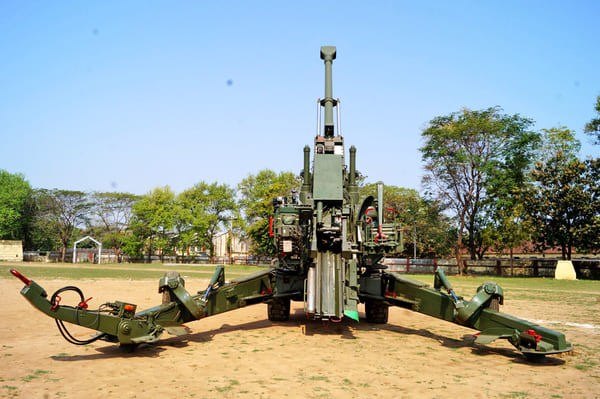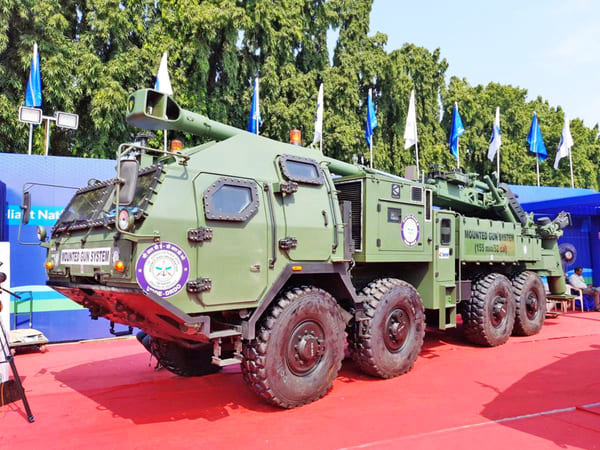Artillery Modernisation Plan on Track
The war in Ukraine has underscored the importance of long-range firepower, both precision as well as saturation. Indian Army has decided to advance its firepower, with a greater emphasis on mobility, precision attacks, range, quick strikes, and survivability. The Army is also ramping up its weapons including guns, rocket systems, and missiles. All regiments would be equipped with advanced 155mm artillery gun systems, inducting missiles and rockets with longer ranges, lethal ammunition, reorganisation of surveillance, and shortening the sensor-to-shooter loop for swift detection.
The Army is looking for lighter, more versatile guns that will be developed and manufactured in India for its requirement of mainstay towed artillery. Interactions are on with the industry to draw up qualitative parameters for the requirements that is likely to be for close to 1,200 guns in future.
At present, the bulk of artillery guns in the Army are 130 mm field guns that are slowly being upgraded to 155mm under the Sharang project. Sources said that an order for 300 upgrades is still pending with the erstwhile Ordnance Factory Board and 25% of the guns have been delivered, with the rest promised to be handed over in two years.
Mounted Howitzers
The Indian Army is all set issue a tender to Indian firms to buy 200 new mounted howitzers equipped with 105 mm 37 calibre guns. This acquisition will boost Indian Army’s mobile firepower in high-altitude border areas like the Line of Actual Control with China.
This would be the first time that the Indian artillery would have these types of 105 mm mounted howitzers and would add to the strength of the formations deployed in forward positions. The Indian Army is modernising the artillery through the indigenous route using the capabilities of the Indian firms as the Indian industry has developed capabilities in this field and is now even exporting these systems to foreign countries.
Towed Guns
Additionally, the defence ministry is also soon going to take up the case of clearing procurement of 400 new towed gun systems (TGS) under the Make in India route. The proposal for procuring 400 towed artillery gun systems is expected to come up for discussion in the Defence Acquisition Council meeting scheduled for November 30. Indian Army’s Regiment of Artillery is looking to use the expertise of Indian Industry to produce 155 mm/52 calibre Towed Gun System, which will be lighter, versatile and cater for future technological advancements.
The Indian Army has moved a proposal to the defence ministry to buy 400 howitzers from Indian firms. This initiative will further accelerate the ongoing push to promote indigenously designed and developed weapon systems.

The new 155 mm/52 Calibre Towed Gun Systems (TGS) are going to be the mainstay gun of the artillery in the future. The Indian Army’s Regiment of Artillery is looking to use the expertise of Indian Industry to produce 155 mm/52 calibre Towed Gun System, which will be lighter, versatile and cater for future technological advancements.
The Indian Designed, Developed and Manufactured (IDDM) howitzer would mean that it would be totally Indian in all ways. The Army wants the guns to be lighter in weight and easier to deploy in high-altitude areas like the older Bofors guns. The procurement process is part of the Army’s modernisation plan with indigenous guns and is likely to be completed by the year 2042.
Advanced Towed Artillery Gun Systems
A tender for buying 307 Advanced Towed Artillery Gun Systems along with one for finding a mounted gun system for its requirements along borders with China and Pakistan has already been issued by the Indian Army. The Indian Army wants the indigenously designed, developed and manufactured howitzer to be lighter in weight and easier to deploy in high-altitude areas. The procurement process is part of the Army plan for mediumisation with indigenous guns and is likely to be completed by the year 2042.
ALSO READ: Replacements of outdated artillery inordinately delayed by 20 years – CAG
The order for 307 of the indigenous guns is to be split between Tata and Bharat Forge who jointly developed it with DRDO. The Army is awaiting commercial offers from the two companies to take the process forward. The lowest bidder will be awarded 60% of the contract and the other company will get 40%, provided they match the price offered by the lower bidder.
The DRDO began a project called Advanced Towed Artillery Gun System (ATAGS) in 2013 to replace older army guns with a modern 155mm artillery gun. DRDO partnered with Bharat Forge and Tata Advanced Systems — to manufacture the gun, which has a range of 48 km.
Dhanush Guns
The India-made 155mm 45-calibre Dhanush is an electronically and mechanically upgraded version of the imported 155mm 39-calibre FH 77 BO2 guns, better known as Bofors.
Having ordered 114 Dhanush artillery guns, the Army already has one regiment operational and is expecting to receive all the guns by 2026.
ALSO READ: Dhanush 155mm Gun Clears Firing Test
Dhanush has demonstrated a range of 38 km with specialised ammunition. It. The Advanced Weapons and Equipment India Limited (AWEIL), carved after corporatisation of the Ordnance Factory Board, now manufactures the Dhanush guns.
Past Purchases
Four contracts have been concluded for the procurement of a 155 mm howitzer in the last decade. These gun systems have already been inducted and more Regiments are being equipped with these guns. These gun systems include Dhanush, Sharang, Ultra-Light Howitzer and K-9 Vajra Self-Propelled Guns. Dhanush guns are an electronic upgrade of Bofors guns, while the Sharang guns have been up-gunned from 130mm to 155mm calibre. Seven Regiments have already been equipped with ULHs while five have been equipped with self-propelled guns.
Pinaka MLRS
The Army is also looking at increasing the range of the Pinaka Multi-Rocket Launch Systems (MRLS) and the DRDO is working on it.
Currently, the Army has four Pinaka regiments and six more are expected to be inducted in the next few years. In addition to adding numbers, the Army is keen on extending its range as well the configurations available. The induction of additional regiments of Pinaka is likely to commence shortly. The DRDO is also exploring increasing the range of Pinaka rockets to 120 km and 300 km.
The range of the original Pinaka rockets was 37 km which was enhanced to 45 km with the upgraded Mk-1, while the guided Pinaka has a range of 75 km which the Defence Acquisition Council has already cleared for procurement.
In April 2022, DRDO and the Army had successfully flight-tested Pinaka Area Denial Munition rocket system. Pinaka with a range of 120 km is under development. The Army is scheduled to conduct trials of these extended and guided Pinaka rockets very soon, sources said.
The Army has five Grad rocket regiments and three Smerch regiments both of Russian-origin among other MRLS. Smerch is the longest range rocket system in the Army’s inventory with a range of 90 km. Pinaka will eventually become the mainstay of multi-rocket systems.
Urgent Priorities
The urgent priorities of the army also include buying more self-propelled K9 Vajra-T guns manufactured by Larsen & Toubro with technology transfer from South Korean firm Hanwha Techwin, mounted gun systems, modern towed gun systems, and equipping more regiments with Dhanush artillery pieces and upgraded Sharang guns. The army has inducted 100 155mm/52 calibre K9 Vajra-T guns under a 2017 contract worth $720 million, and several of them have been deployed in Ladakh.
Comments
The Russia-Ukraine conflict has reaffirmed the primacy of firepower as a battle-winning factor, therefore, the Army has revised its profile of weaponry. One of the key lessons learned from the 19-month-old war is to deploy more self-propelled and mounted gun systems for improved mobility, missiles, and rockets with superior range, ensuring increased survivability against the enemy.
The Regiment of Artillery is also in the process of procuring niche technology including loitering munitions, swarm drones, and tactical remotely piloted aerial systems in order to augment and strengthen its intelligence, surveillance, and reconnaissance architecture to achieve enhanced battlefield transparency. The induction of these potent niche fire power systems will enable delivery of decisive and destructive firepower and will restore the status of artillery as the ‘Arm of Decision.’ Due focus is also being given to ensure networked and automated systems and as part of this process, major upgrades are happening shortly in the Artillery Combat Command and Control System (ACCCS). Even the Battlefield Surveillance System (BSS) is being fielded shortly, the media report further stated quoting a source.


















